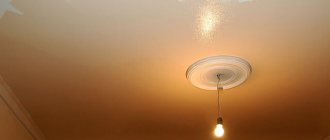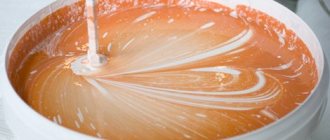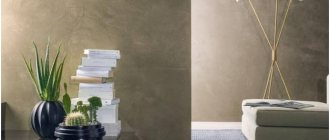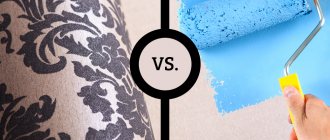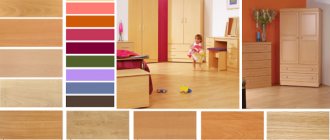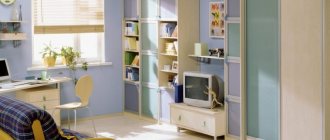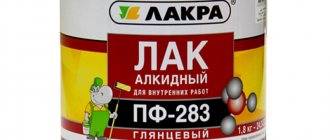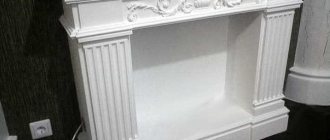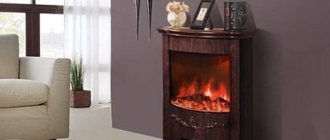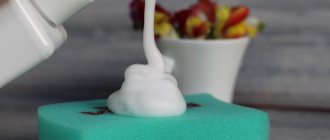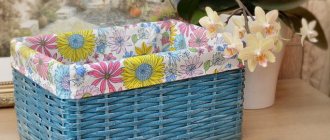The trends in modern construction are such that many residents, having received a warrant for their own apartment, immediately begin renovation work: building partitions, laying floors, installing interior doors and doing finishing work on ceilings and walls. Sales analysis shows that the share of water-dispersion paints reaches up to 25...30% of total sales of consumable building materials. They are technologically advanced enough for residents to do the painting work on their own. The price range is quite attractive. I like the relatively low consumption - from 200 to 300 ml per square meter of the surface to be painted.
Water-based and water-dispersed paints
The differences between water-based and water-based paints are as follows:
- for water-based paints, all components are in the form of a chemical solution without suspended particles;
- Water-dispersed paints contain suspended particles. This is a colloidal solution of coloring pigments in a solvent.
Even when selling online, sellers sometimes cannot tell the difference between these consumables. The main difference is that water-dispersed coatings are thicker and more durable, the consumption of dyes is at least 330 ml per sq.m.
What to choose
When painting bathrooms with moisture resistance, the walls of which are finished with plaster coatings, plastic, concrete, plywood, acrylic paints will have undoubted advantages. For finishing plaster or drywall, but with low requirements for durability, it is permissible to use water-based paint. When finishing external surfaces, metal (for example, roofing), it would be ideal to use polyurethane or rubber paints. Latex is suitable for painting metals, glass and reinforced concrete, while alkyd enamels can be used very effectively on basement walls.
Features of water-based paint: pros and cons of use
Users note various advantages of water-based paints over other paints and varnishes:
- the high drying speed is liked by craftsmen and amateurs who carry out repairs using these coloring compounds;
- the absence of pungent odors during work, as well as after drying, attracts everyone; gases harmful to health are not formed; during work, there is no need to use complex eye and respiratory protection devices;
- By adding the desired color to a can of white paint, you can achieve any shade. Here the user's imagination receives food for experimentation. Even the most fantastic colors can be achieved;
- It’s easy to wash off residues from your hands, face and clothes; water with the simplest detergents will remove traces of coloring components;
- The technology for applying paint to ceilings, walls and other surfaces is simple; after an hour of work, any amateur becomes a professional who can boast of the results of his work.
The disadvantages of water-based paint are:
- the need for storage at a positive temperature, it cannot be left on the balcony waiting for warming, the structure is destroyed when frozen and cannot be restored;
- Basically, water emulsions give a matte finish;
- The dyeing process must be carried out at temperatures above +5...+7 °C.
Calculation of the amount of paint
On the paint label, manufacturers indicate the recommended consumption - the maximum area that can be painted with 1 liter of the mixture in 1 layer. High-quality compositions that cover a light surface are applied in 2 layers, and to cover the contrasting substrate, the number of repeated applications is increased to 3–4. Porous wall materials can absorb some of the paint, so an additional coat may also be required, as for surfaces with unevenness and defects.
When buying paints, the application of which will be accompanied by manual tinting, it is advisable to purchase an additional volume for insurance. In this case, it is recommended to initially mix a large amount of the color coating, since it is almost impossible to achieve an exact match of the shade again.
Types of water-based paints
Depending on the type of binder used, it is customary to divide water-based paints into:
- acrylic, acrylic resins are used here, they determined the name. Most users prefer them. After drying, a durable film is formed that can be washed if necessary. Some cans indicate that the coating can withstand up to five thousand wet washes. As an additional option, crushed latex may be present; it significantly improves the properties of the paintwork, it is better resistant to atmospheric influences, and also becomes resistant to UV radiation;
- silicone ones contain high molecular weight silicone resins. They have high hiding power and can paint over surfaces with cracks, since the coating penetrates deeply into the walls. Usually silicone is present together with acrylic, which improves the structure of the painting composition. The high cost is compensated by special properties, which is why painters love this type of paint. The layer is vapor permeable, it is recommended even for damp rooms; fungus and mold do not form on painted walls;
- silicate are a solution of liquid glass in which colored pigments are present, silicate coating has a number of advantages: long service life (up to 20 years), weather-resistant, can be used for painting facades and fences, protects against fire;
- mineral ones use cement or lime as binders, the main area of application is painting brick and concrete walls. The main disadvantage is the limited service life;
- polyvinyl acetate contains finely ground pigments on a polyvinyl acetate base, forming a fairly durable coating that is resistant to moisture, fats or mineral oils. When exposed to sunlight, it does not decompose within 10...15 years.
Properties
Water-based paint is distinguished by a unique application technology. From the point of view of the person applying the paint, the painting process is the same, but at the molecular level there are major changes in composition. Before application, the paint is water with many additives mixed in it. These particles are not dissolved in water, but are simply mixed in it, and being in this state, they do not interact with each other.
When applied to the surface, a significant change in composition occurs:
- the water evaporates, activating the paint particles;
- the binding substances come closer together, turning into an even, homogeneous layer;
- Hardeners impart relative rigidity to the coating.
Considering that the solvent in these types of paints is water, no harmful or toxic substances are released during evaporation. The fire hazard of painting work is also minimized.
Another clear advantage is durability and the ability to apply a new coat directly over old paint. Before applying a new coat, there is no need to carry out special treatment or remove old paint (provided that the old coating was not oil-based).
A negative property of water-based paint is the corrosion effect when pure metal comes into contact with water. But a number of manufacturers, using modern additives, have launched paint production that minimizes such consequences.
Compound
The exact composition will vary depending on the paint manufacturer and its purpose, and is usually kept secret by the company. But, without going into the smallest details, it can be said that any water-based paint consists of the following components:
- 40-60% water and film former dissolved in it;
- 30-40% fillers and coloring pigments;
- 5-10% plasticizers;
- 5-10% other additives.
To create façade paints, antifreeze is always used to withstand negative temperatures, and acrylic resins to impart elasticity to the finished paint layer. Ultraviolet and infrared filters are also used to prevent damage caused by solar activity. Waterproof paint is obtained by adding synthetic rubber or its analogues to the composition.
Best before date
Shelf life directly depends on storage conditions. Manufacturers guarantee complete safety of the product for at least 6 months, the same period is fixed by the current GOST. The paint should be stored in sealed original packaging without exposing it to sunlight. The storage temperature is strictly positive, from +5 to +30°C. Transposition is allowed at negative temperatures, but not more than 1 month.
In fact, the paint can be stored at least twice as long, and some manufacturers still indicate a period of 12 months on the packaging. After this period, the paint will begin to lose its properties, but for local work, many people use 2-year-old remains of already open paint. It is better to comply with the temperature requirements, because a significant part of the paint is water, which can turn into ice.
Viscosity in DIN
According to the current GOST, the viscosity of water-based paints is at least 30din. The vast majority of manufacturers supply paint with a viscosity of 50-60 or more, for subsequent dilution with a solvent. Measurements must be carried out at paint and ambient temperatures within 18-22°C, otherwise the indicators will not be correct.
Depending on the method of applying paint, the optimal viscosity of the composition will change:
- 20-25 when using a spray gun;
- 30-40 for a roller
- 40-50 for a brush.
When diluting water-based paint with water, it is recommended to use only distilled water. Ordinary water from the tap or the nearest body of water is not suitable due to the various impurities it contains. When applying paint with such water to a surface, white marks and stains will remain after the water evaporates.
Manufacturers of water-based paints
On the Russian market, various manufacturers offer their products for painting walls and ceilings. The modern buyer has a choice.
Dulux (Great Britain) offers water-based emulsion for various purposes, the largest range of interior paints. A look at the composition shows that the main emphasis is on acrylic dyes.
Rice. 1 Facade paint for wooden fences produced by Dulux Products are offered with different properties depending on the strength of the film created, the emphasis is on narrow specialized use. Hence the rather high price range; a higher quality product is sold at a higher price.
Caparol (Germany) describes all the advantages of its product with German meticulousness. The quality of the paints is the highest. The price is high. Painted products do not need to be repainted for decades. You need to require a certificate of conformity, sometimes you can buy something else instead of German quality;
Rice. 2 Silicone based paint
Tikkurila (Finland) – Finnish paints have proven themselves well in the Russian market, craftsmen especially appreciate products for outdoor work, the price is somewhat lower than German ones, and the quality is often even higher;
Rice. 3 Latex paint from Tikkurila
Dufa (Germany) is another German representative; the products of this manufacturer are purchased by wholesalers for painting large objects. Sensitive discounts are noted here. Paints were in great demand during the construction and modernization of stadiums for the World Cup. Dufa was the main supplier;
Rice. 4 Latex paint for kitchens and sanitary units from Dufa
Sniezka (Poland) is a Polish manufacturer of paints; in a number of regions of the Russian Federation its products are presented in a wide range. The quality is not bad, in many respects it corresponds to domestic products.
Rice. 5 Paint for walls and ceilings from Sniezka What makes Sniezka products attractive is that they offer paint in containers from 400 ml to 70 liters. The buyer can always choose the right quantity so as not to spend money on unnecessary volumes;
Admiral (Russia) is a domestic manufacturer that produces good quality paints. Claims sometimes arise against a retail chain that does not organize proper storage. Water-based paints are resistant to freezing;
Rice. 5
Eurolux (Russia) - this manufacturer produces paints of excellent quality. They can compete with English, Finnish and German ones. The main advantage is that with excellent performance, the price of Eurolux is one and a half to two times lower.
Rice. 7 Acrylic-based paint about Eurolux
Which water-based paint should a home craftsman choose? When choosing a dye for repair work, you should know exactly for what conditions the material is being purchased. If you need to paint the ceiling, you should not buy a more expensive product. The coating on the ceiling does not experience mechanical stress, so it needs to be purchased purposefully. The price varies quite widely.
If you use ceiling paint for walls, then you can expect the phenomenon of delamination of the paint coating. You will have to make claims to yourself. A stingy person will definitely pay twice. This principle is clearly visible when purchasing and using water-based paints.
